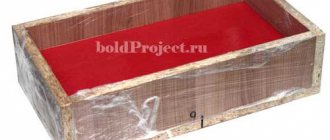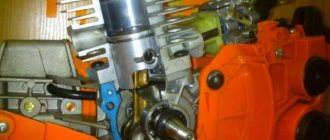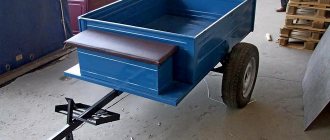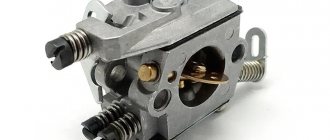A wood sawing machine (saw bench) is a rather complex special production equipment that requires strict adherence to safety measures during operation. In the conditions of the Russian Federation, your own sawmill can greatly reduce the cost of wooden construction and/or become a source of stable income. The purpose of this publication is to help the reader understand how to make a sawmill with your own hands, choose a suitable design for yourself and avoid insurmountable difficulties in its manufacture.
Necessary materials
Structurally, all sawmills are divided into two types:
- With the supply of logs to a stationary saw unit.
- With the movement of the saw unit relative to a fixedly fixed log.
The machines of the latter type include the common band sawmills (“ribbons”). Chainsaw-based sawmills are made according to the same principle.
The log is fixed with clamps on the frame, and the saw unit moves along it along the guides.
The main material for such a device is rolled metal. This can be a square or rectangular profile, round pipes, rods, angles, channels and small rails as guides, similar to elevator ones.
This material is used to collect:
- frame on which the chainsaw is mounted,
- frame for placing logs,
- guides for vertical and horizontal movement of the saw unit relative to the log.
It makes no sense to give any cost for such rolled metal. An owner who decides to assemble such a frame on his own can choose either expensive thick-walled hot-rolled steel or lighter-weight cold-bent steel. The only requirement is that the rental must withstand loads and not bend during operation.
In many cases, material for homemade sawmills is simply collected from scrap metal or from available material at hand. Therefore, theoretically, the range of metal prices for a rigid frame is from 0 to 15-25 thousand rubles.
The length of the logs that are supposed to be cut also matters. For a long round timber you will need a bed of the appropriate length. And multi-meter rolled products are much more expensive and are rarely found in scrap metal.
In the video, an example of a compact homemade unit for cutting short lengths.
Wood is not used for the frame because it is susceptible to warping. The location of the log on it will constantly change, and it will not be possible to achieve stable cutting accuracy.
In addition to rolled metal for the frame and guides, you will need screws to secure the saw unit and the log. The assembly of the frame itself is also sometimes performed using threaded connections, especially if the sawmill needs mobility. Then the frame can be disassembled and transported to any place.
For stationary use, welded joints are more often used.
Mini
A further development of Logosol’s idea is a mini sawmill without a frame, guide and rails, see fig. on right. Instead of a guide, an existing saw cut is used; With careful manual sawing, its accuracy within the log is maintained. In this case, in addition to the tire and drive, only the support platform and handles for holding and moving remain on the carriage.
The pioneer cut is made according to a template (a flat board, top right in the figure), a channel, a frame from an angle, etc., longer than a log. Subsequent horizontal ones are the same as the previous one, in the center on the right. If a vertical cut is necessary, place a channel (bottom right), because in this case, a flat lateral supporting surface is needed. However, all this does not eliminate the last problems: installing the log on the carriage, leveling it and holding it.
Mini sawmill without a frame and how to use it
Which saw should you choose?
All hand chainsaws are, in principle, designed for cross cutting. In this case, the operating mode with maximum load can be considered short-term. The thickest log rarely exceeds 0.7-0.9 m in diameter. A cross cut is carried out in a short time. Next, the internal combustion engine cools down for some time, idles or turns off.
When longitudinal sawing, it is necessary to cut up to 6 m. In this case, the chainsaw operates at maximum load for quite a long time. For this reason, only reliable professional chainsaws with a long service life and good maintainability are suitable for such sawmills.
The engine power should be from 5 hp. and higher. As an exception in terms of power, you can use old Soviet-made chainsaws. For example, “Friendship-2” (3 hp), “Friendship 4”, 4 hp. and other models. These are durable units, extremely easy to repair and maintain, and were widely used in industrial logging sites in their time. The same applies to chainsaws of the Soviet Ural brand.
The Ural saw is most often used to make a sawmill with your own hands, especially at home - it is cheap and practical.
The big disadvantage of Soviet chainsaws is their heavy weight. But just when used on sawmills, weight does not matter, the saws are fixed and do not have to be held in your hands.
Among modern chainsaws, we can recommend the professional, original Shtil and Husqvarna.
No one forbids using light household chainsaws with a power of about 2-2.5 hp or a more powerful one from the budget category, for example Kruger GCSK 35-45 or Shtil 180. But the laws of physics and mechanics cannot be fooled. Such power units can only be used for sawing small products, and in practice they will not last long in this mode.
DIY Instructions
Sawmill from chainsaw Ural
Before starting work, a drawing is selected or created, or at least a sketch of the future product. It is advisable that the dimensions of at least the main parts be indicated. This will make the work much easier and faster. It will be possible to immediately cut the workpieces to length, and then begin assembly.
The general appearance and capabilities of the future unit can be selected and seen both in practice, using the example of band saws or chainsaws, and on the Internet in numerous videos on this topic. When choosing options according to the type of which you plan to make your own version, it is better to choose the simplest ones, with a minimum of complications and details.
This video shows the simplest device of this type. We see a pulling cable that the operator winds with the help of a handle, ensuring that the chainsaw is pulled along the log. But at the same time it is clear that the operator not only tightens the cable, but also simply moves the unit by hand. Obviously, a sawmill of this type can be made either with such a broaching device, or in an even simpler version, without it. Then the chainsaw is moved by hand.
The main requirements for any design and material:
- Sufficient strength.
- The absence of large backlashes when the working unit moves along vertical and horizontal guides.
It should be remembered that excessive strength makes the entire structure heavier and more expensive, and too tight a fit of moving parts in the guides eliminates backlash, but can lead to jamming during operation.
Having experience, you can start work without a drawing, or with a simple sketch - a sketch. Work without a drawing is carried out blindly, and unexpected errors often emerge. In addition, all dimensions will have to be remembered or written down on paper. And recording dimensions indicating the location of parts automatically leads to the creation of at least a simple sketch.
After selecting or creating a drawing (sketch), the blanks are assembled. A set of necessary rentals, fasteners and other necessary parts is assembled.
Next, the rolled metal is cut to length, and the blanks are assembled until the entire structure is ready.
We recommend watching the video below for more details on how to make a sawmill from a Ural chainsaw. The author talks in detail about all the manufacturing steps and also gives dimensions. We recommend watching this useful video.
Mini sawmill from Shtil chainsaw
Such units are assembled in exactly the same order and principle as using chainsaws of other brands. But there are a few differences.
The dimensions and shape of the modern Shtil chainsaw are completely different from those of Soviet chainsaws. Therefore, when attaching the chainsaw itself to the frame, fasteners of a different shape and size are used.
When designing, the power of the unit is taken into account. For example, the Shtil MS 880 model with a power of 6.4 kW (8.7 hp) with a bar length of 70 or 90 cm can cut thicker logs of great length. Consequently, in order to use the unit to its fullest, a frame of greater width and length is designed.
How to make a Logosol type sawmill based on the Shtil MS 660 professional chainsaw is shown in the video below. The manufacturing stages are not described, but how it is constructed and the operating principle of the main components is clear.
Portable sawmill from Druzhba chainsaw
When manufacturing a sawmill using this unit, the features of the model are also taken into account. For example, the less powerful “Druzhba 2” is suitable for trimming thin gauges (understock) and does not require a wide and powerful bed. “Druzhba 4” is capable of sawing larger logs, and this is also taken into account during the design.
If the bed is being prepared for any chainsaw, it is advisable to choose a size that is medium in length and width. The mounting location of the power unit must be designed in such a way that a chainsaw of any size and power can be mounted without problems.
We also recommend reading an interesting article about what other useful things can be made from a Druzhba chainsaw.
We recommend watching an interesting video about what type of sawmill can be made using the Druzhba 4 saw. The author talks about how its device works, the principle of operation, as well as the nuances of making it yourself.
Setting up a band sawmill
The correct operation of the device depends on how correctly all the components of this complex device are configured. The first thing you need to start setting up a sawmill is installing a rail base. For normal safe operation, it is necessary to install the sawmill strictly horizontally to prevent the frame from skewing during operation or from breaking the mechanisms for fixing the log on the frame.
It is especially important to install the base of a mobile sawmill horizontally; to facilitate this process, the kit of such a sawmill includes several hydraulic levels showing the position of the equipment parts relative to the horizontal and vertical.
Setting up a band sawmill also involves calibrating and adjusting control devices. When starting work, the feed speed of the saw blade is usually reduced by ¼, this allows the metal of the belt to warm up. After 5-10 minutes of work, the saw tension is checked and if it sags a little, the tension is increased, after which the feed speed is increased.
Depending on the type of saw blade, the method of sharpening the teeth and their alignment, the choice of blade feed speed is made. The finer the tooth, the more carefully you need to choose the speed of the belt and the feed speed of the frame itself.
During operation, according to the recommendations of the equipment manufacturer, periodic calibration of the vertical feed of the tape is carried out. To do this, a control cut is made on the log and the readings of the graduated ruler on the body of the sawmill are checked with the actual dimensions of the cut.
To check the correctness of the readings of control devices, instrumentation and special equipment are used, this applies, first of all, to such indicators as the speed of rotation of the engine working shaft. When setting up, measurements are taken of its rotation speed at minimum speed, at medium speed and at maximum speed required for the operation of the unit.
Ripping chains
The tooth shape of any cutting blade for longitudinal and transverse cutting of wood is different. The same applies to chainsaw chains. In a hacksaw or two-handed saw for regular cross-cutting, the tooth is located straight, at 90 degrees (along its axis) to the blade.
In rip saw blades, the tooth is inclined forward. Chainsaw chains for rip sawing have a different sharpening angle. You can find such chains on sale. But they are required quite rarely, so there is not a large selection of them on sale. We have to search. In addition, among the variety of chains for different models and brands, choosing a suitable chain is even more difficult.
When such a chain cannot be found, the old ones are resharpened for cross-cutting. In this case, the sharpening angle changes from the usual 30 degrees to 10, sometimes even 5 degrees (almost perpendicular to the axis of movement of the chain).
Sawing along the grain (lengthwise) of chains with both (30 and 5 degrees) sharpening angles will be at approximately the same speed. But at a sharper crosscut angle of 30 degrees, the chain tends to find places in the wood with the least resistance between the fibers and unpredictably pull the cut in that direction. As a result, the tire may bend, make a crooked cut, or jam.
Ready-made frames and mobile attachments
The modern market offers many options for frames for such sawmills, from the simplest clamps (attachments) costing about only 3,000 rubles. to frames similar to a band sawmill at a price of about 50,000 rubles. The latter are rather flimsy-looking structures with a high probability of vibration during operation. There's nothing complicated about it. It is quite possible to assemble such a structure on your own if you have available materials.
If you use more powerful rolled metal, the structure itself will be much stronger and more reliable than that offered at a fairly high price.
The simplest attachment for longitudinal sawing.
Alternatively, such an attachment can be used as a ready-made unit when assembling a homemade sawmill. It makes it possible to vertically raise and lower the cutting set relative to the log. All that remains is to organize the movement of the nozzle along the horizontal guides of the homemade frame.
Mobile carriage for longitudinal cutting of logs based on the Husqvarna 142 chainsaw
The author of the video tells how he made a mobile carriage for longitudinal cutting of logs based on a Husqvarna 142 gasoline saw. With this saw and carriage he sawed through a very large volume of material and built an entire house. The video contains everything you need to make the device yourself. We recommend viewing, very useful.
Video about the nozzle from the store
You can see what kind of devices they sell in the store in this video.
Main types of sawmills
There are the following types of sawmills:
- Frame. It is a structure with flat saw blades mounted on a frame. Frame sawmills are most often installed in large woodworking shops. This device is distinguished by its high power and robust design. The frame sawmill does not require additional maintenance. Its disadvantage is the large thickness of the cut, which increases the amount of chips produced.
- Tape. Processing of workpieces is carried out using a saw band, regulated by stabilizing rollers. The cutting element makes only translational movements obtained from the rollers. Band sawmills are used in small woodworking shops.
- Disk. It is one of the most common types of manual sawmills. It is equipped with a disc with teeth. Each tooth cuts a small part of the log. To improve productivity, these machines are equipped with several cutting discs.
- Chain. Sawing of logs is carried out using a chain saw mounted on a frame with a metal profile. The chain sawmill is lightweight and small in size. Therefore, this mini-machine is most often used in domestic conditions.
When choosing a sawmill, it is necessary to determine the volume of workpieces processed and the operating conditions of the equipment. You also need to take into account the technical characteristics and materials from which the cutting elements are made. One of the main selection criteria is the strength of the structure. The woodworking machine must be able to support the weight of the logs being processed.
How to work with a homemade device correctly
The safety rules when working on such devices are the same as for any woodworking machines. The operator and bystanders must not approach the cutting blade. It is undesirable to work tired, with reduced reaction. Common sense should be used. Clothes should be buttoned and pulled up, without loose hems that could get caught in the chain.
If there is a wide spread of sawdust, you should wear safety glasses. When working for a long time, it is advisable to wear headphones to protect against noise.
Technical features:
- Do not put pressure on the cutting unit. The saw advances as sawdust is removed from the cut, without effort.
- Do not use chains with dull teeth or tires with worn grooves.
Care and maintenance of the entire chainsaw is the same as for normal cross-cutting use. But they are more careful to ensure that the engine does not overheat due to prolonged operation.











